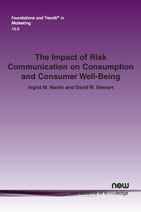The Impact of Risk Communication on Consumption and Consumer Well-Being
By Ingrid M. Martin, California State University, CA 90840, USA, Ingrid.martin@csulb.edu | David W. Stewart, Loyola Marymount University, CA 90045, USA, David.stewart@lmu.edu
Abstract
In this monograph, we build on the risk communication and the psychology of information processing and decision-making literatures, while extending this work through an explicit discussion of the philosophical foundations of risk communication, regulations, and the implications for communication and policy decisions. In addition, we explore the multidimensional context in which individuals confront risks and make trade-offs with respect to the costs and benefits in specific situations. We discuss various examples of risk-related products and behaviors, which are offered to illustrate the issues that arise when addressing risk in a multidimensional context where scientific information is incomplete and/or ambiguous and there are economic and social costs, as well as benefits, associated with any policy related to communicating and managing risk.
Questions remain about how government and policy can respond to the increasing pace of technology change. The regulatory process is, by definition, slow and has difficulty keeping up with the accelerating dynamics of the environment. Are there more responsive market mechanisms that can substitute for government regulation, while still providing protection to individuals? Finally, as society creates “safer” products and processes, there is the potential for triggering more severe risks as a result of the feeling of safety and security.
The Impact of Risk Communication on Consumption and Consumer Well-Being
The Impact of Risk Communication on Consumption and Consumer Well-Being aims to understand how consumers think about and respond to risk through their consumption behaviors. Risky consumption poses societal risks leading to regulatory decisions such as bans on smoking, the use of seatbelts and motorcycle helmets, and so on. In the end, the goal of risk communication is consumer well-being by mitigating the harm of risky consumption.
The authors synthesize the literature on risk, risky consumption behaviors, risk communication, and consumer well-being. They extend prior reviews through an explicit discussion of the philosophical foundations of risk communication and management and the implications of specific foundations for communication and policy decisions. In addition, the monograph explores the implications of the multidimensional context in which individuals confront risks and make trade-offs with respect to risks and benefits in specific situations.
The authors discuss various examples of risk-related products and behaviors throughout the monograph to illustrate the issues that arise when addressing risk in a multidimensional context where scientific information is incomplete and/or ambiguous and there are economic and social costs and benefits associated with any policy related to communicating and managing risk. These examples are intended to provide a context for the complex issues that are the focus of this monograph.
